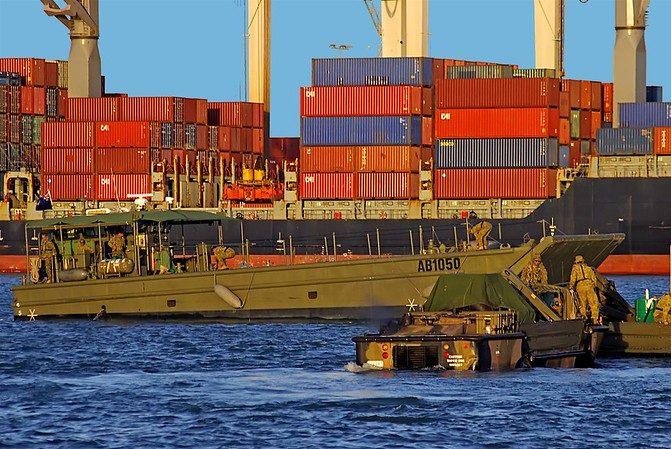What should modern nation-building look like?
Posted By Gill Savage and John Coyne on May 28, 2021 @ 06:00

As Australia moves through the stages of recovery from Covid-19, we’re increasingly urged in mainstream and social media to support local, visit local and live local. From Mudgee to Mildura, Batemans Bay to Bundaberg and beyond, regional Australia is working hard to reframe, reshape and reposition for a more prosperous and resilient future.
Today’s regional resurgence is coming from within as local communities recognise the impact the pandemic lockdowns have had on city dwellers and the opportunity that Covid-recovery investment represents. However, even the most visionary of regional Australia’s leaders cannot achieve this on their own.
Our new ASPI report, Collaborative nation-building: Port of Townsville case study [1], launched today, looks at how one organisation is collaborating with governments and industry to deliver bigger benefits at the local level. The report highlights the need for a sustainable nation-building agenda that goes beyond short-term ‘sugar hit’ investment.
The theme for this report is nation-building. Not the kind of one-off investment ‘announceables’ we’re familiar with that connect cities with roads, but nation-building that is big-picture, courageous and reminiscent of the big ideas of the past. These are initiatives that build the infrastructure from which economic, social and national security opportunities grow.
Nation-building has come in and out of favour over time. Perhaps Australia’s most iconic example is the building of the Snowy Mountains Hydro-electric Scheme [2] that commenced in 1949 and was completed in 1974. The project was more than an engineering feat. Its 100,000 workers came from more than 30 countries. Many had escaped the horror of post-war Europe to begin a new life where former enemies and allies worked side by side [2]. While the design and construction are still recognised as statements of Australian innovation and ingenuity, those workers had a significant and lasting impact in shaping Australia and building our nation.
Regional areas understand the need for this style of nation-building. The size of their budgets and revenue bases are such that the margin for financial error is slim, so growth needs to be based on big thinking. Regional Australia also understands that the recovery from the Covid-19 recession means now is the time to set a nation-building agenda.
This special report looks at what’s happening today in the Townsville region, using the Port of Townsville as an example of what’s possible, and at what others at regional, state and national levels can pursue beyond one-off investments to drive nation-building that then drives more sustainable benefits.
This examination of the Port of Townsville’s $1.62 billion expansion to meet needs over the coming 50-years is one example of the big thinking that’s occurring across regional Australia. The case study illustrates that planning for a better future doesn’t happen overnight.
The Port of Townsville’s decade-long journey started with a vision, planning and initial environmental approvals, and is now being pursued through collaborative engagement not common in the sector. While the ports sector tends to take a long-term view in terms of management and expansion, it’s still unusual for individual ports to actively engage with trading partners in a strategic way and beyond the boundaries of specific projects.
Covid-19 has reminded us that Australia can achieve great things when governments (including Defence, as is the case with Townsville), the private sector and the community work together. The Port of Townsville’s engagement approach is unusual for its sector and to some extent for Defence. While local commanders actively engage with local and state officials, they sometimes have limited knowledge of and scope to shape Australian Defence Force initiatives to optimise benefits at the local level. Defence’s engagement with the development of the Port of Townsville is different: it includes local commanders but also the big decision-makers in Canberra.
Floods, drought, bushfires and now Covid-19 have hit the region around Townsville hard, but it’s seizing the opportunity to reshape, reframe and reposition.
The report identifies several opportunities to increase prosperity in the region.
One is to collaborate rather than compete. This particularly relates to the Port of Townsville’s relationship with other hubs, especially given the increasing importance of strategic geography [3]. It makes no sense to compete directly with other regions.
Another is to establish a medical hub to support Pacific partners. While some of these activities are defence-focused, there’s also opportunity for Townsville to leverage its university and medical facilities to become an education and medical hub for the Pacific.
A third is to continue to use and invest in the Townsville region as a forward operating base for Australia’s activities into the Pacific. While it will never have a major fleet presence, Townsville is a viable staging post into the Pacific. Missions to Bougainville and deployments to Fiji as part of the Pacific step-up [4] and humanitarian assistance and disaster relief are good examples. Its geostrategic importance is already established, and the Australian government should formally acknowledge that.
A collaborative approach to nation-building like this is not new but we haven’t engaged in this way for decades.
As a nation, we’re out of practice.
Article printed from The Strategist: https://aspistrategist.ru
URL to article: /what-should-modern-nation-building-look-like/
URLs in this post:
[1] Collaborative nation-building: Port of Townsville case study: https://www.aspistrategist.ru/report/collaborative-nation-building-port-townsville-case-study
[2] Snowy Mountains Hydro-electric Scheme: https://www.snowyhydro.com.au/about/history/
[3] strategic geography: /the-australian-defence-forces-presence-in-northern-australia-must-be-increased/
[4] Pacific step-up: https://www.dfat.gov.au/countries/pacific-step
Click here to print.